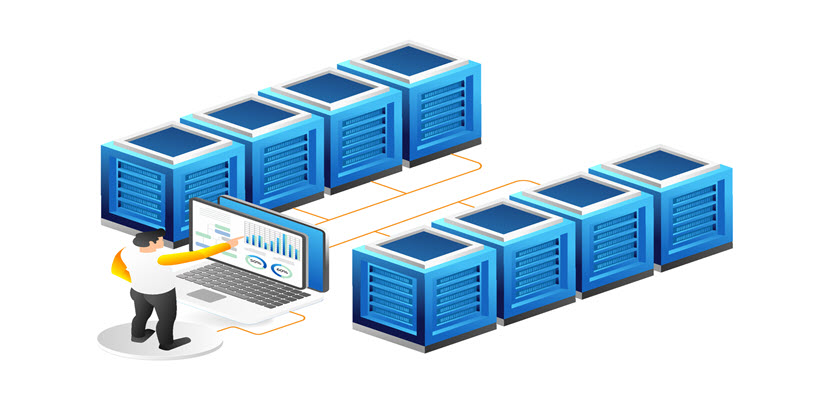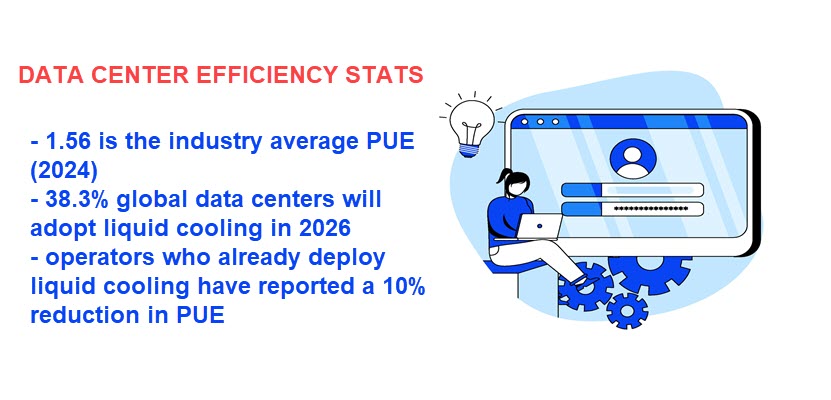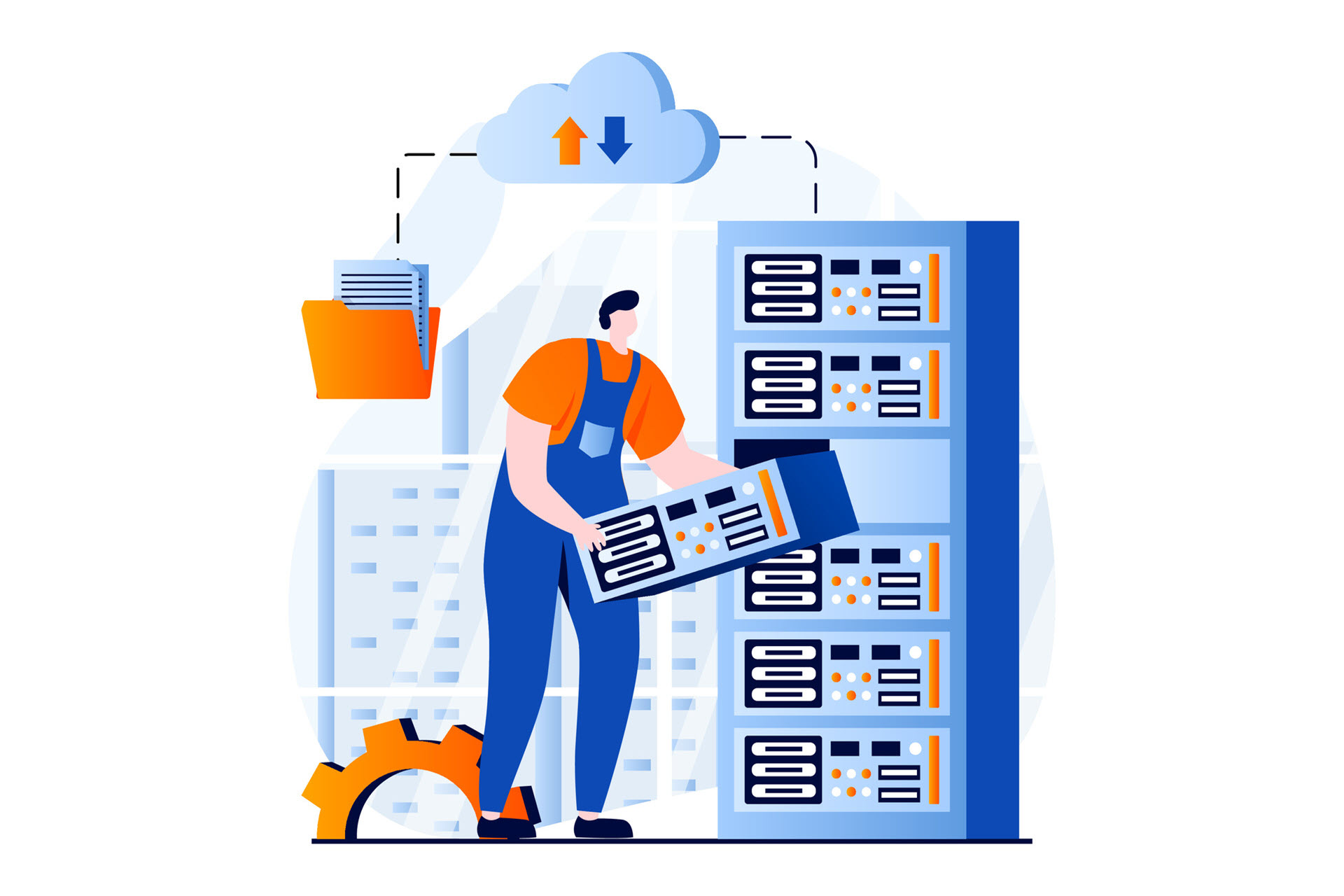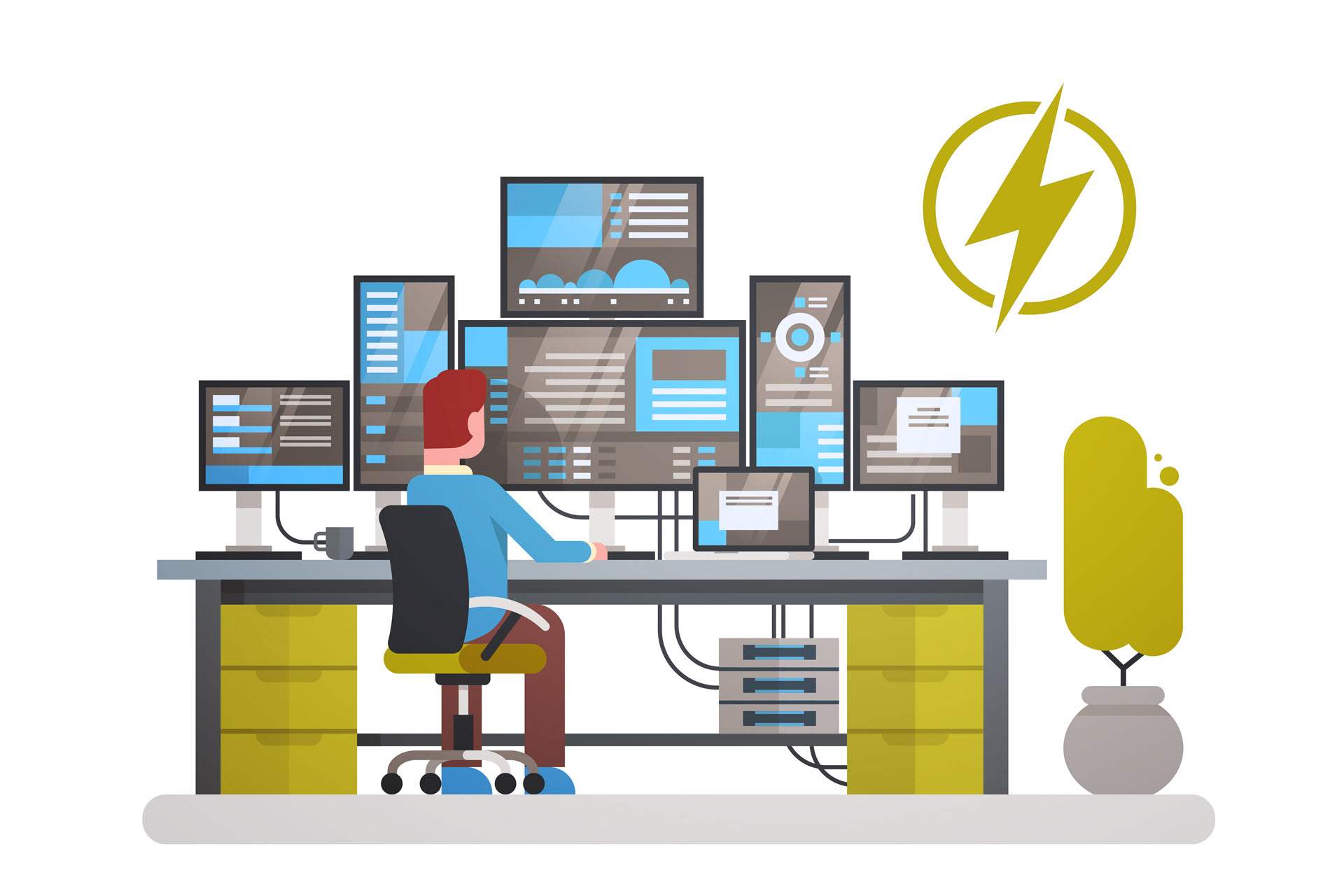Data center energy efficiency refers to the strategies and technologies used to minimize power consumption while maintaining high performance and reliability. As modern data centers handle increasing workloads, energy demand continues to rise, resulting in higher operational costs and a greater environmental impact.
Improving efficiency has become essential to reduce carbon footprints, meet regulatory requirements, and ensure long-term sustainability. This is achieved through advanced cooling systems, optimized hardware utilization, and renewable energy integration.
This article examines the fundamental principles of data center efficiency, its challenges, and the solutions that are shaping energy-efficient data center operations.

What Is Data Center Energy Efficiency?
Data center energy efficiency is the process of optimizing how a data center consumes power to deliver maximum computing performance with minimal energy waste. It focuses on reducing the amount of electricity required to run servers, storage, networking equipment, and supporting infrastructure such as cooling and power distribution systems.
An energy-efficient data center balances performance, availability, and sustainability. This is achieved by implementing technologies and strategies such as virtualization, high-efficiency power and cooling systems, workload consolidation, and the adoption of renewable energy. The goal is to lower operational costs, extend equipment life, and minimize environmental impact, while still ensuring reliable IT service delivery.
A common metric for evaluating data center energy efficiency is power usage effectiveness (PUE), which compares total facility energy consumption to the energy actually used by IT equipment. Lower PUE values indicate a more efficient data center.
Data center energy efficiency is one of the many factors that contribute to the success of your operations. To learn more about them, check out our article on data center reliability.
Why Is Data Center Energy Efficiency Important?

Improving energy efficiency in data centers is crucial not only for cutting costs but also for ensuring long-term sustainability and reliability. Let’s examine the key factors that significantly influence the efficiency of operations and minimize the overall environmental and financial impact of modern data centers.
Sustainability
Data center energy efficiency involves strategies such as advanced cooling technologies, deploying renewable energy sources, and optimizing server utilization to reduce waste. Sustainable data centers also prioritize responsible water use, efficient space design, and the adoption of circular economy practices like equipment recycling and reuse. By reducing carbon emissions and operating costs, sustainability initiatives not only support environmental goals but also strengthen compliance with regulations and improve long-term business resilience.
Reliability
Stable energy management directly supports reliability and uptime. Overstressed power and cooling systems are more prone to outages, which lead to downtime and service interruptions. Data centers minimize strain on infrastructure by ensuring that workloads remain available and resilient. Reliability is especially critical for industries that depend on uninterrupted operations, such as finance, healthcare, and cloud services.
Regulatory Compliance
Governments and industry bodies are imposing stricter energy efficiency and emissions standards on data centers. Non-compliance can result in fines, penalties, or restrictions on future growth. Data centers not only stay compliant but also position themselves as leaders in meeting evolving regulatory frameworks by adopting efficiency measures.
Competitive Edge
Customers and partners are increasingly looking for providers that demonstrate environmental responsibility and operational efficiency. An energy-efficient data center offers a strong value proposition by reducing costs, ensuring uptime, and supporting sustainability goals. This effort translates into improved reputation, market differentiation, and greater customer trust.
Power Savings
Electricity is one of the highest operational costs for data centers. Operators significantly reduce expenses by optimizing power consumption across servers, storage, and networking devices. Efficient power usage also extends hardware lifespan by preventing overloading and unnecessary energy waste. The financial savings from lower energy bills can be reinvested into infrastructure upgrades or innovation.
Cooling Optimization
Cooling systems often account for nearly half of a data center’s energy consumption. Inefficient cooling not only drives up power costs but also increases the risk of thermal issues that can degrade equipment performance. Energy-efficient cooling strategies reduce reliance on traditional HVAC systems while keeping servers at optimal temperatures. This method strikes a balance between cost control and environmental sustainability.
Learn more about cooling strategies for modern data centers in our article on data center cooling.
Estimating Data Center Energy Consumption
Estimating data center energy consumption involves calculating the total amount of electricity required to power IT equipment and the supporting infrastructure that keeps it running. This process provides insight into operating costs, identifies areas of inefficiency, and helps operators plan for future capacity needs.
Here is a step-by-step explanation of how to measure data center energy consumption:
- Measure the power draw of IT equipment. Servers, storage arrays, and networking devices represent the core computing load and are typically measured in kilowatts (kW). Modern power distribution units (PDUs) and intelligent monitoring systems provide real-time visibility into consumption at the rack or device level.
- Account for supporting infrastructure. Focus on power distribution losses, uninterruptible power supplies (UPS), and cooling systems. Cooling in particular can consume nearly as much energy as the IT equipment itself. Metrics such as PUE are used to capture the relationship between total facility energy and IT equipment energy, with a lower PUE indicating a more efficient data facility.
- Check the workload variability. Energy use fluctuates depending on server utilization, peak demand times, and workload distribution. Estimating consumption requires analyzing usage patterns and applying statistical models to project both average and peak consumption scenarios.
- Apply tools and platforms to audits. Energy modeling software, data center infrastructure management (DCIM) platforms, and facility audits can provide a more detailed assessment of data center efficiency. These approaches help organizations forecast future requirements, optimize resource allocation, and evaluate the impact of efficiency improvements before implementation.
Accurate estimates of data center efficiency are essential for budgeting, sustainability reporting, and compliance with efficiency regulations.
Current State of Data Center Energy Efficiency
The energy footprint of data centers is under increasing scrutiny as digital demand and AI workloads drive rapid growth. While efficiency technologies have advanced, overall power use continues to rise, and regulators are pushing for broader reporting on energy, water, and heat reuse.
Global data center electricity consumption is increasing rapidly, primarily driven by the exponential growth of artificial intelligence workloads. While new facilities are being designed with advanced efficiency measures, the sheer pace of AI adoption is pushing energy demand upward faster than efficiency gains can offset it.
Industry surveys in 2024 report an average PUE of 1.56, showing little improvement compared to recent years, with the exception of Google (1.09) and Amazon (1.15). While hyperscale operators continue to design state-of-the-art facilities with much lower PUE values, a vast number of legacy enterprise and colocation sites remain locked at higher levels, pulling the overall average down.
Cooling has emerged as the most pressing challenge as rack power densities continue to climb. Traditional air cooling struggles with the thermal loads of GPUs and accelerators, forcing operators to explore liquid-based solutions. Although only about 20% of data centers currently deploy liquid cooling, nearly a third plan to adopt it within the next two years. Industry standards and design practices are rapidly evolving to accommodate higher heat flux, with the American Society of Heating, Refrigerating, and Air-Conditioning Engineers (ASHRAE) publishing guidance on best practices for liquid cooling.
Overall, the current state of data center energy efficiency is marked by both progress and pressure. While operators have made meaningful advances in cooling design, energy sourcing, and sustainability tracking, the unprecedented scale of AI-driven workloads is overshadowing incremental gains. The next phase of efficiency will likely be defined by the rapid adoption of liquid cooling, integrated carbon and water metrics, massive renewable energy procurement, and mandatory transparency enforced through regulation.
How to Improve Data Center Energy Efficiency?
Improving data center energy efficiency requires a combination of technical upgrades, operational best practices, and strategic planning to reduce energy waste without sacrificing performance or reliability. The following steps outline practical ways operators can achieve measurable gains:
- Optimize cooling systems. Deploy advanced techniques such as hot and cold aisle containment, liquid cooling, and free-air economization to minimize reliance on traditional HVAC units.
- Consolidate and virtualize workloads. This method reduces underutilized servers, ensuring higher efficiency from existing hardware.
- Upgrade to energy-efficient equipment. High-efficiency power supplies, servers with better performance per watt, and intelligent PDUs for granular monitoring use less power to fuel a data center’s daily operations.
- Implement DCIM tools. Track real-time power usage, identify inefficiencies, and adjust resource allocation dynamically.
- Integrate renewable energy sources. Procure green power contracts to offset environmental impact and reduce carbon footprints.
- Maintain regular audits and capacity planning. Allow operators to fine-tune PUE, anticipate demand spikes, and avoid overprovisioning.
- Train staff on energy-aware practices. Proper operational discipline ensures that technical investments translate into consistent efficiency improvements.
By combining infrastructure upgrades, smarter workload management, and disciplined operational practices, data centers can significantly reduce their energy footprint while maintaining performance and reliability.
The Future of Data Center Energy Efficiency

With the increasing adoption of artificial intelligence, data centers are spending more electricity than before to maintain their hardware at optimal operational levels. According to the Berkeley Lab’s 2024 report on U.S. data center energy usage, power utilization for data center efficiency and cooling has grown by 4% compared to the previous year.
Market trends predict that data centers have a good chance of achieving energy efficiency through sustainability. Raising rack densities are driving the need for higher supply temperatures, but this can be mitigated with the wider adoption of direct liquid cooling. Additionally, the EU is promoting more frequent use of the Water Usage Effectiveness (WUE) metric, which aims to reduce water waste during data center cooling.
AI-driven load growth also strains power grids. A projected 20 GW of new U.S. data center demand by 2030 may drive consumption to 12% of national electricity by 2028, according to Reuters. Additionally, leading providers are adopting innovations such as 400V DC distribution and 1MW water-cooled racks. This can improve power efficiency by approximately 3%, according to TechRadar.
In conclusion, data center efficiency is entering a pivotal phase. The industry faces mounting pressure to support the expansion of AI while simultaneously curbing its environmental footprint. Providers that embrace liquid cooling, advanced power architectures, and sustainable resource management will be best positioned to thrive in a future where energy efficiency is no longer optional, but fundamental to competitiveness and resilience.
To learn more about how artificial intelligence affects your data center, read our article on AI impact on data centers.
Choosing an Energy-Efficient Data Center
Selecting the right data center partner is one of the most effective ways to reduce your organization’s energy footprint while ensuring reliable IT performance. Not all facilities are built or operated with efficiency in mind. This is why it is critical to evaluate providers based on their infrastructure, cooling methods, and sustainability practices.
phoenixNAP offers a compelling choice for businesses seeking energy-efficient hosting solutions. Our global data center network is designed with efficiency at its core. It features advanced power distribution, precision cooling systems, and strict adherence to ASHRAE and industry best practices. By leveraging innovative cooling technologies and high-efficiency power infrastructure, phoenixNAP minimizes energy waste while supporting high-density workloads, including AI and GPU clusters.
Beyond physical infrastructure, phoenixNAP integrates sustainability into operations. Facilities designed with efficiency metrics in mind ensure optimal power utilization for both IT systems and supporting infrastructure. Our approach enables clients to achieve both cost savings and measurable progress toward their environmental goals.
phoenixNAP’s infrastructure is engineered for high availability and resiliency, ensuring that efficiency never comes at the expense of uptime. Businesses can count on continuous operations supported by redundant power, network, and cooling systems.
Balancing Performance with Sustainability
Data center energy efficiency is no longer optional. It is essential to control costs, ensure reliability, and meet global sustainability goals. As workloads become increasingly demanding, the ability to optimize power and cooling has become a crucial factor in achieving success.
Strategies such as workload consolidation, advanced cooling methods, and renewable energy adoption enable organizations to minimize their environmental impact. Implementing these measures can also lead to significant cost savings and strengthen a company’s reputation for sustainability.



